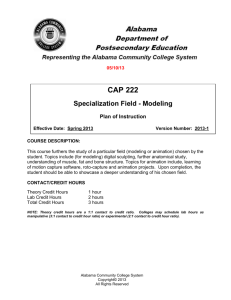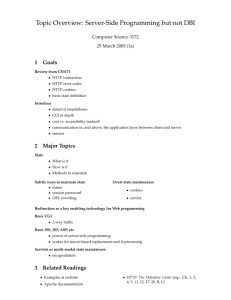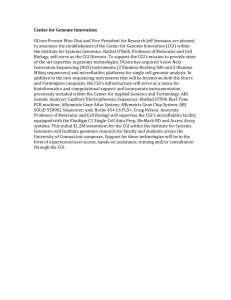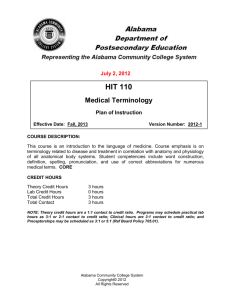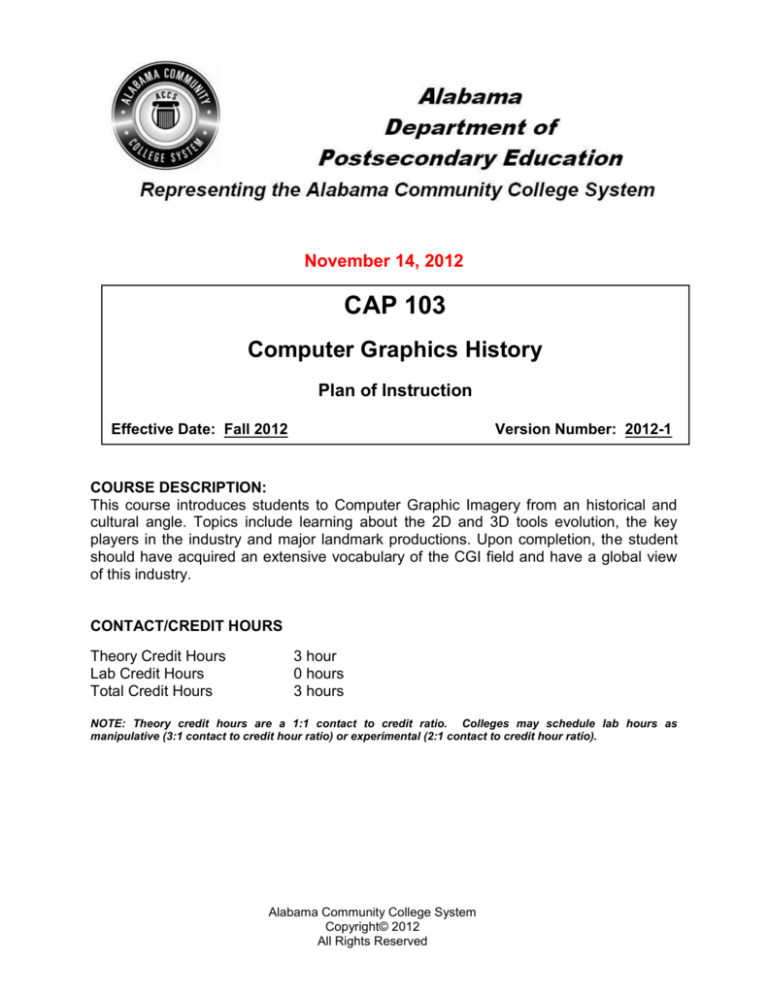
November 14, 2012
CAP 103
Computer Graphics History
Plan of Instruction
Effective Date: Fall 2012
Version Number: 2012-1
COURSE DESCRIPTION:
This course introduces students to Computer Graphic Imagery from an historical and
cultural angle. Topics include learning about the 2D and 3D tools evolution, the key
players in the industry and major landmark productions. Upon completion, the student
should have acquired an extensive vocabulary of the CGI field and have a global view
of this industry.
CONTACT/CREDIT HOURS
Theory Credit Hours
Lab Credit Hours
Total Credit Hours
3 hour
0 hours
3 hours
NOTE: Theory credit hours are a 1:1 contact to credit ratio. Colleges may schedule lab hours as
manipulative (3:1 contact to credit hour ratio) or experimental (2:1 contact to credit hour ratio).
Alabama Community College System
Copyright© 2012
All Rights Reserved
Computer Graphic History
CAP 103
PREREQUISITE COURSES
As determined by college.
CO-REQUISITE COURSES
As determined by college.
PROFESSIONAL COMPETENCIES
Describe the key events, people and technologies linked to CGI.
Discuss the extraordinary events that shaped the CGI landscape.
INSTRUCTIONAL GOALS
Cognitive – Comprehend CGI timeline and technology evolution.
Psychomotor – Can discern roughly the age of a production or visual effect.
Affective – Value the importance of knowing past events to better understand
the fast evolving nature of this field.
STUDENT OBJECTIVES
Condition Statement: Unless otherwise indicated, evaluation of student’s attainment
of objectives is based on knowledge gained from this course. Specifications may be in
the form of, but not limited to, cognitive skills diagnostic instruments, manufacturer’s
specifications, technical orders, regulations, national and state codes, certification
agencies, locally developed lab/clinical assignments, or any combination of
specifications.
ACCS Copyright© 2012
All Rights Reserved
2
Computer Graphic History
CAP 103
STUDENT LEARNING OUTCOMES
MODULE A – COMPUTER GRAPHICS MILESTONES
MODULE DESCRIPTION – This module instructs students on key milestones and
breakthrough discoveries in the CGI field. Topics include pioneers of CGI, breakthrough
movies, notable organizations, computer science research, and the movement from
analog to digital.
PROFESSIONAL COMPETENCIES
PERFORMANCE OBJECTIVES
KSA
A1.0 Describe the key events,
A1.1 This competency is measured
2
people and technologies linked
cognitively.
to CGI.
LEARNING OBJECTIVES
A1.1.1
A1.1.2
A1.1.3
A1.1.4
A1.1.5
A1.1.6
A1.1.7
A1.1.8
Identify CGI pioneers in their relative field.
Identify geographical context of CGI.
Describe CGI common vocabulary.
Identify movie breakthrough timeline.
Describe institutes and production companies.
Identify Computer Science role.
Describe transition from analog tools to digital.
Explore famous case study.
KSA
2
2
3
2
3
1
2
3
MODULE A OUTLINE:
Computer Graphic Milestones
Pioneers of Computer Graphic Imagery
Breakthrough movies
Notable organizations
Computer Science research
From analog to digital
MODULE B – CASE STUDY
MODULE DESCRIPTION – This module instructs students on recent and upcoming
movies and the companies responsible for the VFX industries in the U.S. and the world.
PROFESSIONAL COMPETENCIES
PERFORMANCE OBJECTIVES
KSA
B1.0 Discuss the extraordinary
B1.1 This competency is measured
2
events that shaped the CGI
cognitively.
landscape.
LEARNING OBJECTIVES
KSA
B1.1.1 Describe the first use of CGI in a movie.
B1.1.2 Describe the context of the introduction of the first CGI animated
character in a movie.
2
1
ACCS Copyright© 2012
All Rights Reserved
3
Computer Graphic History
B1.1.3
B1.1.4
B1.1.5
B1.1.6
CAP 103
Explain the importance of the visual effects in the movie Abyss.
Describe how Jurassic Park was the turning point of stop motion effects.
Explain the impact of Terminator 2 on movie production.
Describe the impact of full length 3D movies as Toy Story on 2D
animation field.
B1.1.7 Explain the renaissance of stereo movie with the case of Avatar.
2
2
3
2
3
MODULE B OUTLINE:
Case study
2001 Space Odyssey
Young Sherlock Holmes
The Abyss
Jurassic Park
The Terminator 2
Pixar Movies
Avatar
ACCS Copyright© 2012
All Rights Reserved
4
Computer Graphic History
CAP 103
LEARNING OUTCOMES TABLE OF SPECIFICATIONS
The table below identifies the percentage of learning objectives for each module.
Instructors should develop sufficient numbers of test items at the appropriate
level of evaluation.
Limited
Knowledge and
Proficiency
Module A
Module B
ACCS Copyright© 2012
All Rights Reserved
1
12%
14%
Moderate
Knowledge
and
Proficiency
2
50%
57%
Advanced
Knowledge
and
Proficiency
3
38%
29%
Superior
Knowledge
and
Proficiency
4
5
Computer Graphic History
Indicator Key Terms
1
Limited
Knowledge
and
Proficiency
2
Moderate
Knowledge
and
Proficiency
3
Advanced
Knowledge
and
Proficiency
4
Superior
Knowledge
and
Proficiency
A
Affective
Objective
ACCS Copyright© 2012
All Rights Reserved
CAP 103
Learner’s Knowledge, Skills and Abilities
Description
Recognize basic information about the subject including terms
and nomenclature.
Students must demonstrate ability to recall information such as
facts, terminology or rules related to information previously
taught.
Performs simple parts of the competency. Student requires
close supervision when performing the competency.
Distinguish relationships between general principles and facts.
Adopts prescribed methodologies and concepts.
Students must demonstrate understanding of multiple facts
and principles and their relationships, and differentiate between
elements of information. Students state ideal sequence for
performing task.
Performs most parts of the competency with instructor
assistance as appropriate.
Examines conditions, findings, or other relevant data to select an
appropriate response.
The ability to determine why and when a particular response is
appropriate and predict anticipated outcomes.
Students demonstrate their ability to seek additional information
and incorporate new findings into the conclusion and justify their
answers.
Performs all parts of the competency without instructor
assistance.
Assessing conditions, findings, data, and relevant theory to
formulate appropriate responses and develop procedures for
situation resolution. Involves higher levels of cognitive
reasoning.
Requires students to formulate connections between relevant
ideas and observations.
Students apply judgments to the value of alternatives and select
the most appropriate response.
Can instruct others how to do the competency.
Performs competency quickly and accurately.
Describes learning objectives that emphasize a feeling tone, an
emotion, or a degree of acceptance or rejection.
Objectives vary from simple attention to selected phenomena to
complex but internally consistent qualities of character and
conscience.
Expressed as interests, attitudes, appreciations, values, and
emotional sets or biases.
6


